Iraq, home of the earliest civilisation namely the Sumerian civilisation in the fertile Tigris-Euphrates river valley, is the birthplace of writing and wheel. Modern Iraq corresponds to the Mesopotamia (Land between the rivers) of the Old Testament. Iraq with its legendary Babylon has been on top of my must-see list. My friends thought I was crazy to join an 11-day tour to Iraq. I had an unusual holiday visiting Baghdad, Babylon, holy shrines for Shia Muslims at Karbala and Najaf, fabulous archaeological sites at Uruk, Ur and Lagash and a nature wonderland, the Marshes.
Our group of 27 (26 participants and a group leader, Peter Cheng) departed Hong Kong for Dubai after midnight and arrived in Baghdad, capital of Iraq around 10am. As our group was the first tour group to Iraq, TVB interviewed a few members at the airport and the news was aired in Hong Kong while we were in Iraq.
The Baghdad airport facilities are totally inadequate. The arrival hall is tiny, poorly lit and designed without proper signage. We were told to present ourselves at the visa office and then to go through the immigration check point. As no one except arriving and departing passengers are allowed to enter the airport area, we had to take a bus to the car park several kilometres away to meet our guide.
My first impression of Baghdad is surreal. The road was empty with few signs of life or activities. Not many vehicles and people could be seen. Barbed wire and watch towers dominate the landscape. This gives the feeling of a place under siege or at war. We were not allowed to take pıcture tıll we reached the car park where we saw our old friend Mr. Ahmadi, a tour operator from Tehran and Mr. Basim our local guide from the Babel Tour.
We set off for Ctesiphon at 11am without delay. Ctesiphon is 35km south of Baghdad but the journey took some two hours as there were check points every one or two kilometres. We were escorted by the police in an armored vehicle for parts of the journey.
We returned to the city for a late lunch. We were so hungry that we found the food (chicken, beef and mutton) most delicious. Before returning to the hotel, we visited a popular night market. I saw plenty of shops selling jeans and clothes, kitchen wares, shoes, mobile phones while some street stalls were selling grilled fish, mutton, vegetables, sweet, fruits and nan (bread).
Day 2: Baghdad – Karbala (about 100km; driving 3hrs)
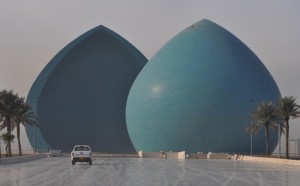 |
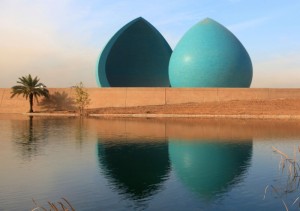 |
Baghdad founded in the 8th century was the capital of the Addasid Caliphate and became a significant cultural, commercial and intellectual centre of the Islamic world. From 11th to 13th centuries, Baghdad was the largest city in the world with an estimated population of 1.2 million. The four surrounding walls of Baghdad were named Kufa, Basra, Khurasan, and Damascus. This wall was about 33m high, 44m thick at the base and 12m at the top. Most of the wall is gone and Baghdad today has a population of 7 million.
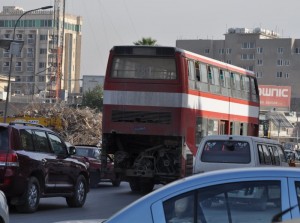 We first went to the Martyr’s Monument, a landmark built by Mitsubishu which looks like a split heart. We were stopped at the entrance but finally got the permission from the senior management for our visit. We were even taken to see the museum below. There is no English explanation and a translator told us about the use of chemical weapons upon the Kurds. A local radio came to cover our visit and asked me about my impression of Iraq.
We first went to the Martyr’s Monument, a landmark built by Mitsubishu which looks like a split heart. We were stopped at the entrance but finally got the permission from the senior management for our visit. We were even taken to see the museum below. There is no English explanation and a translator told us about the use of chemical weapons upon the Kurds. A local radio came to cover our visit and asked me about my impression of Iraq.
We then crossed the Tigris to see the Swords of Qadislyah (Hands of Victory Statue), another iconic symbol of Iraq. As it is located in the Green Zone (the international zone surrounded/protected by concrete walls of 3m high), the guide warned us that the coach might not be able to get close enough for a good photo. He was right and we were not allowed to get out of the coach at all.
We set off for Karbala after lunch. The journey took some three hours as there were numerous check points.
Karbala with more than 100 mosques and some 20 religious schools is the fourth holiest city for Shia Muslims after Mecca, Medina and Najaf. It was the location of the Battle of Karbala, which took place on October 10 in AD 680 when Imam Hussein (the third Imam), grandson of Prophet Muhammad by his daughter Fatima tuz-Zahra and Ali ibn Abu Talib, led his 72 followers and some 200 women and children to fight against the army of Umayyad Yazidibn Mu’awiya when he refused to accept the latter as the caliph. They camped where Karbala stands today from the first day of the Islamic month of Kuharram. His brother Abbas died on the seventh day when he went to the river to fetch water for the thirsty women and the children. Imam Hussein was the last to be killed on the tenth day of the battle which has since been commemorated as the Day of Ashura. Our group was lucky to be in Iraq during the entire 10-day Ashura festival.
The mosques of Imam Hussein and his half-brother Abbas stand at the centre of old Karbala. Their shrines are pilgrimage sites especially on the anniversary of the battle.
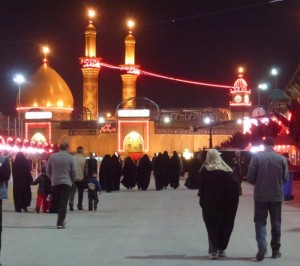 |
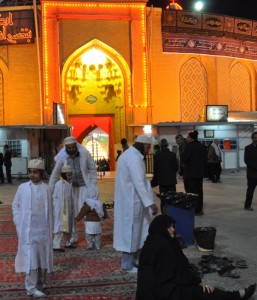 |
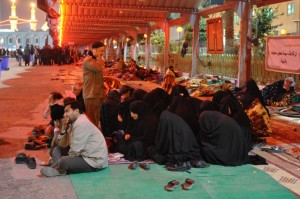 |
Security is tight. We had to go through three check points before entering the Mosques. On each occasion, I was searched from head to toe. The mosques were lit up in the evening and looked very impressive. We reached the concourse between the two mosques but were stopped by the security guard from entering the mosque of Abbas. What a shame!
Day 3: Karbala
Accompanied by a local guide, we spent a whole day in Karbala visiting four mosques. I respect all religions and want to pay respect to great spiritual and religious leaders.
 |
In the afternoon, we went to the shrine of Al Hur, who fought for the army of Umayyad YazidibnMu’awiya till he joined Imam Hussein’s side on the ninth day and died as the first martyr at the battle. His shrine is under renovation and we could not enter.We proceeded to the shrine of Ah Hon, another brave solider who died at the battle. Once again, non-Muslims are not allowed to enter.
The organized tour ended at 4pm. Kylie (my nice roommate), Connie, YY, Ah Wah and I went back to the shrines. The setting sun shined upon the two golden domes and minarets. We watched thongs of pilgrims passing by. Many sat on mattresses listening to the story of the battle, chanting and praying. There were many processions with older men beating drums in the front, younger men and boys moving their swords. What a sight!
We first went to the shrine of Imam Hussein. The crowd was so large that we could hardly move. The air was so stuffy and hot that I could not breathe. When we came out of the shrine, we could not move as thousands of Muslims were praying in the mosque. The atmosphere was most moving. Kylie and I then went to the mosque of Abbas. The crowd had mostly gone and we had time to take a closer look at the shrine and the lit-up courtyard.
We set off after 9am for the legendary Babylon and had our first history lesson on ancient Iraq. Sumer is the ancient name for southern Mesopotamia. Sumerians were the first people known to have created cuneiform, a form of writing. Historians generally divide the Sumerian history into three stages (first stage from 3360 to 2400 BC; second stage from 2400 to 2200 BC and the third stage from 2200 to 2000 BC.).
After the Sumerian rule, the Amorites, a Semitic people from the west established cities on the Tigris and the Euphrates and made Babylon their capital. King Hammurabi (1792-1750 BC), the sixth ruler, reunified Mesopotamia and a huge area stretching from the Tigris-Euphrates river valley from Sumer to the Persian Gulf in the south to Assyria in the north came under his rule. His greatest achievement was the issuance of a comprehensive law code, known as the Code of Hammurabi.
Around 1600 BC, the Hittities (Indo-European-speaking tribes) and the Kassities conquered and destroyed Babylon. The Hittities got out of power around 1200 BC. The Assyrians rose to prominence in the 9th century BC. Two new kingdoms of the Medes and the Chaldeans (Neo-Babylonians) emerged and the latter became heir to Assyrian power in 612 BC. The Chaldeans reestablished Babylon as the most magnificent city of the Near East and the Hanging Gardens famed as one of the Seven Wonders of the Ancient World was built during the reign of Nebuchadnezzar II (604-562 BC). Babylon fell to Cyrus the Great (550-530 BC) becoming part of the Iranian empire (Please read the post on my tour in Iran in 2010-11).
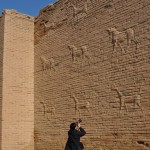 |
|
We spent two hours exploring the ruins which cover a large area. But the most famous Ishtar Gate and the Procession Way are now housed in the Pergamon Museum in Berlin(which I first saw in 1990).Today, one only finds a copy of Ishtar Gate at the entrance, restored walls and Palace of Nebuchadnezzar. The only genuine parts are the foundation, old walls with unglazed brick relief in the depression off the of the Procession way, the slabs and asphalt of the Procession Way, the Lion of Babylon statue in basalt, parts of the Temple of E-Temenanki, and a great mass of bricks.
The value and beauty of this magnificent archaeological site, in my view, have been much destroyed by the poor restoration work carried out by Saddam despite the advice of UNESCO. What a shame!
We then visited the palace built by Saddam at the top of a hill above the archaeological site next to the Tigris. The palace which was looted after the 2003 invasion, now stands empty except for debris.
We arrived in Najaf located 80km from Karbala around 5pm. It is the third holiest city where Imam Ali (the first Imam), cousin and son-in-law of the prophet Muhammad was buried. The Shia sect considers Imam Ali the righteous successor to the Prophet.
Najaf is the centre of Shia political power. It was severely damaged under Saddam’s Sunni-dominate regime. I find the city, which has been undergoing re-development in recent years, surprisingly tidy and well-developed by Iraqi standards.
Our hotel was next to the Holy Shrine of Ali, a grand structure with a magnificent golden dome and many precious objects in the walls. We met a mullah who showed us the courtyard and told us the importance of the shrine where Adam and Noah were also buried. The dome was built with some 4000 pieces of gold. With his special permission, we took a group photo with the dome as the backdrop. He also gave us a book as a souvenir but politely refused our request to visit the holy shrine.
Day 5: Najaf –Kufa– Najaf (20km; driving 1hr)
In the morning, we visited Kufa which was founded in AD 618 by Saad bin Abi Waqqas, the commander-in-chief of the Arab forces. Kufa was the first capital of the Abbasid Empire and the capital of Islam during the Imam Ali era. We put on our chador but were not allowed to enter the mosque (the second oldest mosque in Iraq) where Imam Ali, the fourth caliph and first Imam (656-661) was murdered at the age of 61 while praying. This mosque looks different from other mosques: it has a fortress –like wall measuring 170m long and 4m thick with six semi-circular towers.
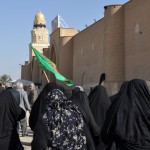 |
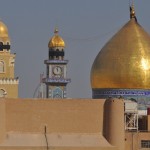 |
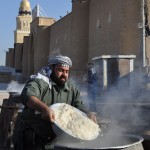 |
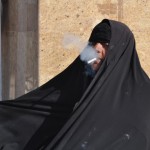 |
We visited Imam Ali’s house next to the mosque and the Al Sahla Mosque. In this small mosque, there are sanctuaries of Abraham, Imam Al-Sadiq, Imam Al-Sajad, Edree, Al-Kheder, Al-Seleheen and Al-Mahdi.
We had our best lunch of the whole trip in a nice restaurant in Najaf. The grilled fish was fresh and delicious and the lamb was excellent. After lunch, we went to the Wadi-us-Salaam cemetery reputed to be the largest in the world and the famous Najaf market. There are many pieces of equipment used by the Iraqi soldiers on sale in the market.
At sunset, I managed to enter the holy shrine of Imam Ali and joined the pilgrims in paying respect to the great religious leader. One of the ladies on duty asked whether I am a Muslim. I replied ‘No’. She was courteous and friendly and let me stay.
After dinner, Kylie and I took a walk in the bazaar. We watched processions marching to the mosque. Interesting and atmospheric! (See Part 2 )


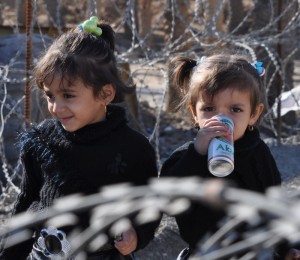
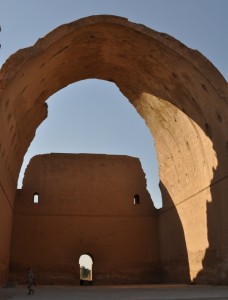
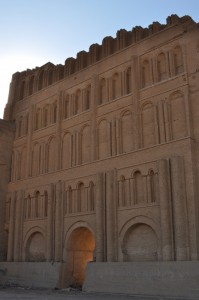
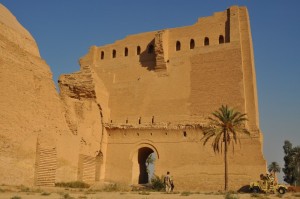
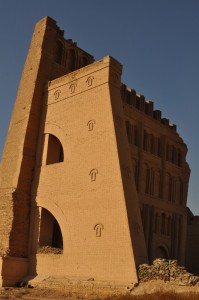
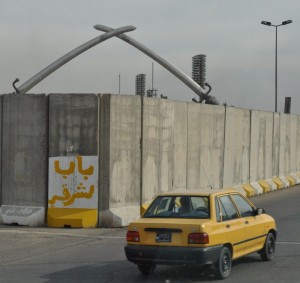
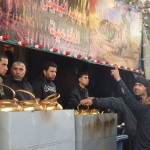
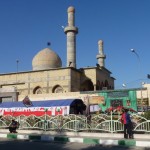
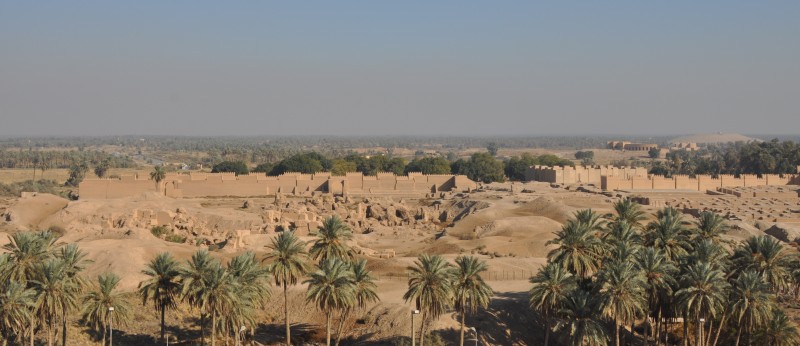
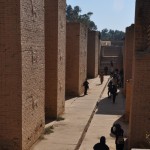
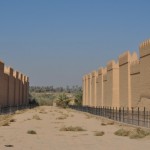
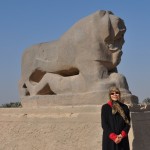
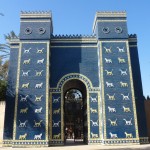
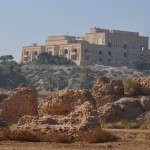
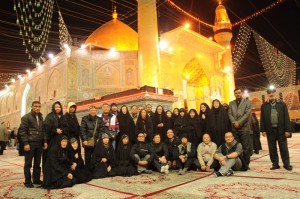
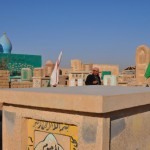
Excellent record of our trip, some of your information to be used in my powerpointshow, thanks.